Common menu bar links
Breadcrumb Trail
ARCHIVED - Immigration and Refugee Board of Canada
 This page has been archived.
This page has been archived.
Archived Content
Information identified as archived on the Web is for reference, research or recordkeeping purposes. It has not been altered or updated after the date of archiving. Web pages that are archived on the Web are not subject to the Government of Canada Web Standards. As per the Communications Policy of the Government of Canada, you can request alternate formats on the "Contact Us" page.
Message from the Chairperson

I am pleased to present the 2009-10 Report on Plans and Priorities for the Immigration and Refugee Board of Canada (IRB).
The IRB is an independent, accountable tribunal whose work reflects Canada's humanitarian and security values and respect for our international obligations. On behalf of Canadians, the IRB hears a wide variety of cases, ranging from family sponsorship appeals and detention reviews to refugee protection claims and admissibility hearings. This year marks the 20th anniversary of the IRB.
IRB personnel recognize the profound impact of our actions and the consequences of the decisions rendered. It is with this sense of responsibility to those who appear before us and to all Canadians who count on us to resolve cases efficiently, fairly and in accordance with the law, that we undertake the plans and priorities presented in this report.
Caseload and decision-maker complement
The IRB operates in a complex and unpredictable environment where the number and type of cases it receives are influenced by shifting migration patterns, refugee movements and other factors. The IRB's three divisions—the Refugee Protection Division (RPD), the Immigration Appeal Division (IAD) and the Immigration Division (ID)—are experiencing substantial growth in their caseload, and this trend is expected to continue in 2009-10. This is particularly the case in the RPD, which has been receiving new claims at a rate well above the level for which it is currently funded.
As a consequence of this increased workload and the continuing shortfall in the Governor in Council (GIC) decision-maker complement, both the RPD and the IAD continue to accumulate large and growing inventories. The IRB is committed to working with the Government so that it may fill GIC decision-maker vacancies with qualified candidates as quickly as possible. At the same time, the IRB continues to find ways to become more efficient while examining the need for additional resources to address its mounting workload pressures.
In light of the difficulty in forecasting external pressures such as the rate and number of new appointments and reappointments, a range has been provided for proposed case completions by the RPD and the IAD.
Continued organizational transformation
The IRB is engaged in various organizational improvements to ensure that it is well positioned to deliver high-quality administrative justice on a timely basis. In 2009-10, we will build on our achievements by further integrating and streamlining our adjudicative support and case resolution processes without compromising fairness.
Key priorities for 2009-10
We have identified the following three strategic priorities for 2009-10 that build on those from the previous fiscal year.
- Further increase capacity to resolve cases and manage the case inventory
- Strengthen relationships with partners and stakeholders
- Continue to build an integrated, flexible and effective organization
In line with these strategic priorities, the IRB will focus on both new and ongoing initiatives in the year ahead. These include:
- Continued, intensive decision-maker recruitment and selection efforts to ensure that the Government is provided with a sufficient pool of qualified candidates for appointment to the RPD and the IAD
- Further enhancement of adjudicative support, including early resolution of cases and improved case-readiness procedures across all divisions, to ensure that files are hearing-ready and to facilitate proactive hearings
- Development and implementation of quality standards for decision-making and adjudicative support to enhance accountability and transparency
- Enhancement of the outreach program with key partners and stakeholders to improve public understanding of the IRB's mandate and operations
Looking ahead
In 2009-10, we will continue to look for opportunities to improve the way we do business so that we may better deliver on our mandate on behalf of Canadians. I would like to acknowledge the dedication and professionalism of IRB personnel, who are key to our success in meeting our objectives for the year ahead. I invite you to read this report and to visit our Web site at www.irb-cisr.gc.ca for more information about the IRB and its plans and priorities.
Brian Goodman
Chairperson
Section I: Overview
Raison d'être and Responsibilities
The IRB is an independent, accountable administrative tribunal that was created on January 1, 1989, by an amendment to the Immigration Act.
| Our mission, on behalf of Canadians, is to resolve immigration and refugee cases efficiently, fairly and in accordance with the law |
In 2002, the Immigration Act was replaced by the Immigration and Refugee Protection Act (IRPA) from which each IRB division derives its mandate.
| Refugee Protection Division (RPD) |
|---|
|
| Immigration Division (ID) |
|
| Immigration Appeal Division (IAD) |
|
Regional Operations
The IRB carries out its work in three regional offices in Toronto, Montréal and Vancouver: the Central Region, responsible for Ontario, except for the Ottawa area; the Eastern Region, responsible for Quebec, the Ottawa area and the Atlantic provinces; and the Western Region, responsible for the Western provinces. All three divisions hold hearings in these regions, supported by operational and adjudicative support. Internal and support services are managed at IRB Headquarters, located in Ottawa.
Administrative Justice
Through each division, the IRB strives to deliver a simpler, more accessible and expedient form of justice than that provided by the courts, but with no less attentiveness to procedural fairness, the rigour of the law and its application to the particular facts of each case. The IRB applies the principles of administrative law, including natural justice, in its proceedings and resolutions, and decisions are rendered in accordance with the law, including the Canadian Charter of Rights and Freedoms.
The IRB is a human rights tribunal, and the human dignity of all those who come before it is respected by the women and men who work at the IRB. The IRB is committed to fairness in all aspects of its work. The Board respects the diversity of individuals who appear before it, some of whom have experienced very difficult circumstances.
Benefits for Canadians
Immigrants and refugees have always contributed significantly to Canada's growth and development. The IRB ensures continued benefits to Canadians in three important ways:
- In hearings on refugee claims, it ensures that Canada accepts those in need of protection in accordance with international obligations and Canadian law
- In hearings on admissibility and detention reviews, it helps ensure the security of Canadians
- As an independent mechanism for resolving sponsorship, removal order and residency obligation appeals, it helps to promote family reunification, helps ensure Canadians' safety and security, and safeguards the integrity of Canada's immigration system
The IRB also contributes more broadly to the quality of life of Canada's communities by strengthening our country's social fabric and by reflecting and reinforcing core values that are important to Canadians. These include respect for human rights, security, fairness, peace and the rule of law.
Organizational Information
Senior management. The Chairperson is the IRB's Chief Executive Officer, senior decision-maker and spokesperson. The Executive Director is the IRB's Chief Operating Officer and is responsible for providing adjudicative and corporate support to the IRB's three decision-making divisions. Two deputy chairpersons (appointed by the GIC) and one director general (appointed under the Public Service Employment Act) oversee decision-making in the three divisions. Four directors general and a senior general counsel (all appointed under the Public Service Employment Act) are responsible for the IRB's operations, legal services, corporate planning and services, communications and human resources functions.
Decision-makers. Decision-makers in the RPD and the IAD are appointed by the GIC. Decision-makers in the ID are public service employees.
Organizational Chart
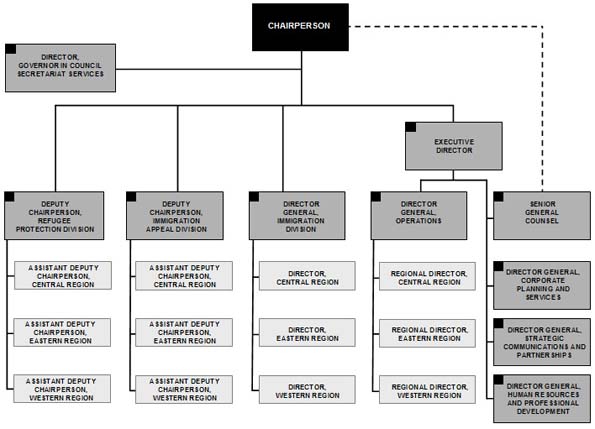
(Click on image to enlarge)
Strategic Outcome and Program Activity Architecture (PAA)
Based on its legislated mandate and its currently approved PAA, the IRB has a single strategic outcome and three program activities that include responsibility for all tribunal decisions and resolutions. The fourth program activity, Internal Services, supports the first three as illustrated by the figure below.
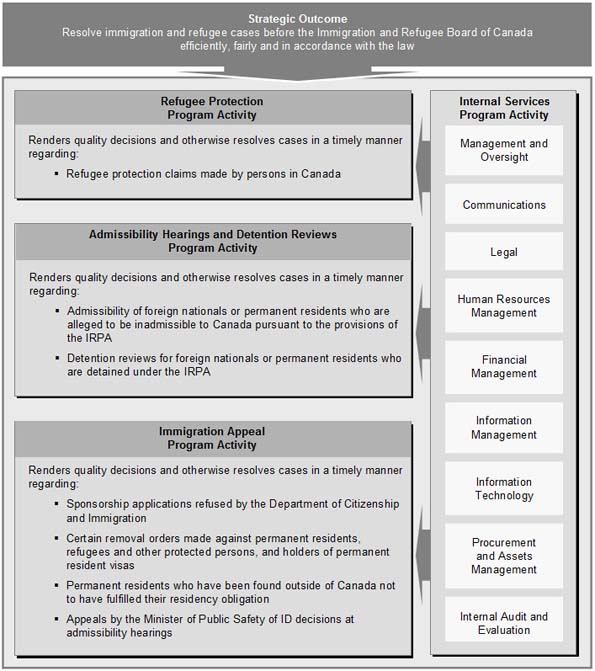
Planning Summary
Financial and Human Resources
| 2009-10 | 2010-11 | 2011-12 |
|---|---|---|
| 113.4 | 113.1 | 112.8 |
| 2009-10 | 2010-11 | 2011-12 |
|---|---|---|
| 1,025 | 1,025 | 1,025 |
Planning Summary Table
| Performance Indicators | Targets |
|---|---|
| In addition to the productivity indicators described for each of the program activities (see Section II), the following quality indicator will be used: Percentage of IRB decisions overturned by the Federal Court | Less than 1% |
| Program Activity | Forecast Spending ($ Millions) |
Planned Spending ($ Millions) |
Alignment to Government of Canada Outcome Area | ||
|---|---|---|---|---|---|
| 2008-09 | 2009-10 | 2010-11 | 2011-12 | ||
| Refugee Protection Program Activity | 59.8 | 60.3 | 60.1 | 60.0 | A safe and secure world through international cooperation |
| Admissibility Hearings and Detention Reviews Program Activity | 8.0 | 11.4 | 11.4 | 11.4 | Safe and secure communities |
| Immigration Appeal Program Activity | 13.8 | 13.2 | 13.2 | 13.1 | A vibrant Canadian culture and heritage; Safe and secure communities |
| Internal Services Program Activity | 30.9 | 28.5 | 28.4 | 28.3 | Government Affairs |
| Total Planned Spending | 112.5 | 113.4 | 113.1 | 112.8 | |
1 For program activity descriptions, please refer to Section II or access the Main Estimates online at http://www.tbs-sct.gc.ca/est-pre/estimE.asp.
IRB Strategic Priorities
The IRB's three strategic priorities for 2009-10 are summarized in the table below.
2009-10 Strategic Priorities
| Priorities | Type | Description |
|---|---|---|
| Further increase capacity to resolve cases and manage the case inventory | Operational Ongoing |
The Board will continue its efforts to assess and recommend qualified candidates to the Minister for appointment to address the shortfall in the GIC decision-maker complement. In addition, the IRB will ensure that it has the necessary resources in place to support its decision-makers. The IRB will also further improve the management of its inventory through innovative case management and adjudicative strategies. |
| Strengthen relationships with partners and stakeholders | Operational New |
The IRB recognizes the importance of positive relationships with its partners and stakeholders. The Board will enhance its outreach efforts and work with key partners and stakeholders to improve public understanding of its mandate and operations. |
| Continue to build an integrated, flexible and effective organization | Management Ongoing |
The Board continues to ensure the consistent delivery of high-quality administrative justice within a changing environment. This transformation process remains a priority in 2009-10, as the Board will further integrate its operations and develop new quality standards in decision-making and adjudicative support to enhance accountability and transparency. |
Risk Analysis
Operating Environment
The IRB carries out its mandate within a complex and ever-changing environment. Both international and domestic factors influence the IRB's operating environment. Conflicts and country conditions abroad can result in refugee movements and inevitably impact the number of refugee protection claims made in Canada. Similarly, shifts in international migration patterns impact the number of people seeking admission to Canada.
Refugee populations. The report Asylum Levels and Trends in Industrialized Countries, First Half 2008, published by the United Nations High Commissioner for Refugees (UNHCR), shows that the number of asylum claims submitted in industrialized countries in 2007 rose by 9% compared to 2006. This upward trend continued in the first half of 2008, with approximately 165,000 claims submitted during this period in the 44 countries surveyed. During this period, only the United States received more refugee claims than Canada.
In Canada, the increase in refugee protection claims that began in 2006 is expected to continue into the 2009-10 reporting period, with Mexico, Colombia and Haiti representing the top source countries for such claims. As of January 2009, we are projecting that the number of claims will increase from 40,000 claims in 2008-09 to 50,000 claims in 2009-10, an increase of 25%. At the same time, the refugee caseload is also becoming more complex, with increased security concerns and fraudulent documentation.
Growing trend of family sponsorships. Immigration continues to be important for Canada, as immigrants represent an increasing proportion of the population. Canada's population of immigrants is expected to reach between 7.0 and 9.3 million by 2017. It is within this context, and consistent with the Government's objective of promoting family reunification that family-class sponsorship applications have increased. With this increase, it is expected that the IRB will continue to receive a high number of family sponsorship appeals.
Challenges
Appointment of decision-makers. Due to a series of transitions in government between 2004 and 2008, the IRB experienced a decline in the rate at which GIC decision makers were appointed and reappointed. The resulting shortfall in decision makers has contributed to the growth of the pending case inventory and to increased average processing times.
While the IRB expects the pace of GIC appointments and reappointments to quicken, it takes approximately six months to train new decision-makers and for them to acquire the experience to become fully productive. In this context, case resolution estimates for 2009-10 for the RPD and the IAD are reported as falling within a range. The upper limit is based on a full complement of decision-makers and the lower limit on a projected vacancy rate of 27%, reflecting the historical appointment patterns of the last two years.
Increase in intake and pending case inventory. The growing inventory is primarily attributable to two external factors: an increasing number of appeals filed and claims referred to the Board; and a reduced number of GIC decision-makers. The IRB is currently funded to finalize 25,000 refugee claims and 6,500 immigration appeals. As of April 2009, it is expected there will be approximately 65,000 refugee protection claims and 10,600 immigration appeals pending. If intake levels and resource levels remain constant, it is expected that the inventory will continue to grow, even with a full complement of decision-makers. While the IRB will continue to seek opportunities to further increase its productivity, workload pressures in the RPD and the IAD are such that changes to resource levels will be required to return the pending inventory to normal operating levels.
Opportunities
Case management. A growing pending case inventory coupled with a shortfall in resources has compelled the IRB to look for innovative ways to address its workload. The Board's case management plan will draw on the benefits of fast track processes, inter regional support and improved case scheduling. These initiatives will leverage the Board's existing resources and tribunal expertise to improve processing times and help reduce the case inventory.
Portfolio management. As immigration portfolio partners, the IRB, CIC and the Canada Border Services Agency (CBSA) collaborate on operational matters while respecting each other's distinct mandates and the IRB's adjudicative independence. A recent trilateral Memorandum of Understanding clearly defines institutional relationships and reflects the current operational environment and priorities of the partners. This new collaborative approach creates opportunities to improve communication and operational coordination. The diagram below illustrates the immigration and refugee portfolio, partners and responsibilities.
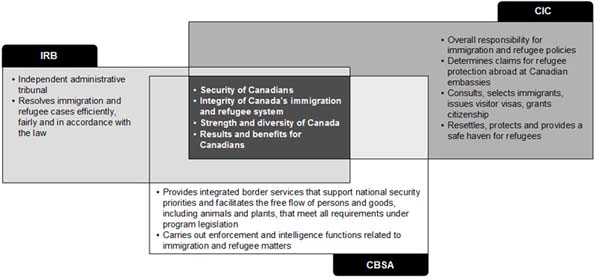
(Click on image to enlarge)
Expenditure Profile
Spending Trend 2005-06 to 2011-12
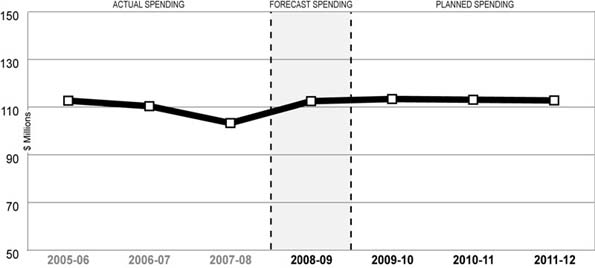
Lower actual spending in 2007-08 in comparison to previous years was primarily due to delays in appointments and reappointments of GIC decision-makers and vacant public service positions. This resulted in fewer adjudicative decisions rendered and translated than originally estimated.
The planned spending for 2009-10 and beyond is expected to remain constant.
Allocation of Funding by Program Activity
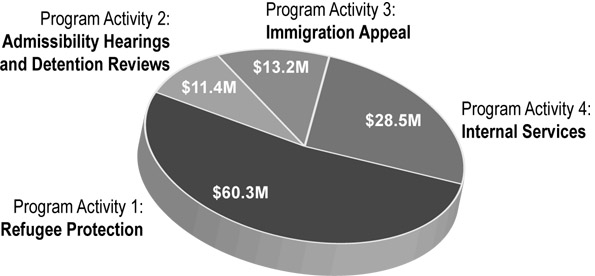
Voted and Statutory Items
| Voted # or Statutory Items (S) | Truncated Vote or Statutory Wording |
2008-09 Main Estimates ($ Millions) |
2009-10 Main Estimates ($ Millions) |
|---|---|---|---|
| 10 | Program expenditures | 100.6 | 100.8 |
| (S) | Contributions to employee benefit plans | 12.8 | 12.6 |
| Total | 113.4 | 113.4 | |
